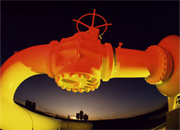The parties highlighted that the long-term strategic cooperation between Russia and Austria in the oil and gas sector had been successfully developing for many decades.
A continuous increase was noted in Russian gas supplies to Austria. Preliminary estimates indicate that in January 2016 the gas exports by Gazprom to the Austrian market grew by 76.2 per cent versus the same period of 2015. Throughout 2015 the gas deliveries rose by 11.5 per cent against 2014.
The parties also discussed the importance of building the Nord Stream 2 gas pipeline to satisfy the growing demand for Russian gas in the future.
Special attention was paid to underground gas storage in Europe. The parties addressed the cooperation progress within the Haidach UGS project – the largest UGS facility in Austria and the second-largest in Central Europe. In 2015 the aggregate working capacity of Haidach had been agreed to increase by 150 million cubic meters, or about 5 per cent. At the same time, its peak daily withdrawal capacity grew by 1.55 million cubic meters. As a result, the UGS working capacity reached 2.98 billion cubic meters and the peak daily output – 29.9 million cubic meters. It was stressed that the storage capacity had been boosted without additional investments.
Russian gas has been supplied to Austria since 1968. OMV is Gazprom's main business partner in Austria.
The Haidach UGS facility is a joint project of Gazprom (the Company owns a 66.7 per cent stake), RAG (Austria) and WINGAS (Germany). The major task of Haidach is to secure the reliability of Russian gas exports towards the Baumgarten hub as well as to consumers in Slovenia, Croatia, Hungary, Austria, Germany, Slovakia and Italy. Haidach is operated by RAG.
On September 4, 2015 Gazprom, BASF, E.ON, ENGIE, OMV and Shell inked a Shareholders Agreement to construct the Nord Stream 2 gas pipeline system with an annual capacity of 55 billion cubic meters from Russia to Germany across the Baltic Sea.
27 Декабря 2025 | суббота | 00:41


